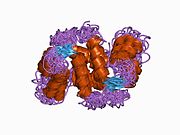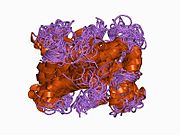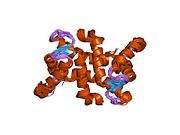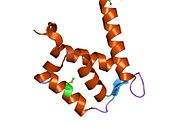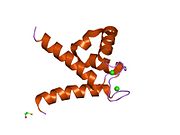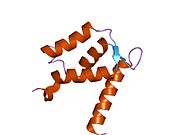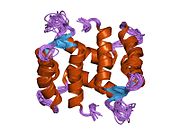
The S100 proteins are a family of low molecular-weight proteins found in vertebrates characterized by two calcium-binding sites that have helix-loop-helix ("EF-hand-type") conformation. At least 21 different S100 proteins are known. They are encoded by a family of genes whose symbols use the S100 prefix, for example, S100A1, S100A2, S100A3. They are also considered as damage-associated molecular pattern molecules (DAMPs), and knockdown of aryl hydrocarbon receptor downregulates the expression of S100 proteins in THP-1 cells.
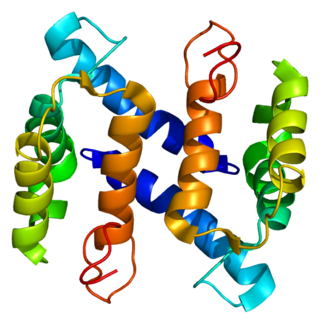
Protein S100-A4 (S100A4) is a protein that in humans is encoded by the S100A4 gene.

S100 calcium-binding protein A7 (S100A7), also known as psoriasin, is a protein that in humans is encoded by the S100A7 gene.

S100 calcium-binding protein A2 (S100A2) is a protein that in humans is encoded by the S100A2 gene and it is located on chromosome 1q21 with other S100 proteins.

S100 calcium-binding protein B (S100B) is a protein of the S-100 protein family.

S100 calcium-binding protein A8 (S100A8) is a protein that in humans is encoded by the S100A8 gene. It is also known as calgranulin A.

S100 calcium-binding protein A9 (S100A9) also known as migration inhibitory factor-related protein 14 (MRP14) or calgranulin B is a protein that in humans is encoded by the S100A9 gene.

Protein S100-A1, also known as S100 calcium-binding protein A1 is a protein which in humans is encoded by the S100A1 gene. S100A1 is highly expressed in cardiac and skeletal muscle, and localizes to Z-discs and sarcoplasmic reticulum. S100A1 has shown promise as an effective candidate for gene therapy to treat post-myocardially infarcted cardiac tissue.

S100 calcium-binding protein A10 (S100A10), also known as p11, is a protein that is encoded by the S100A10 gene in humans and the S100a10 gene in other species. S100A10 is a member of the S100 family of proteins containing two EF-hand calcium-binding motifs. S100 proteins are localized in the cytoplasm and/or nucleus of a wide range of cells. They regulate a number of cellular processes such as cell cycle progression and differentiation. The S100 protein is implicated in exocytosis and endocytosis by reorganization of F-actin.

S100 calcium-binding protein A11 (S100A11) is a protein that in humans is encoded by the S100A11 gene.

S100 calcium-binding protein A12 (S100A12) is a protein that in humans is encoded by the S100A12 gene. Human S100A12, also known as calgranulin C, was first described in 1995.
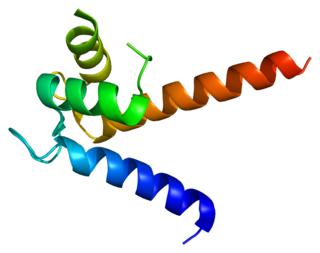
S100 calcium-binding protein P (S100P) is a protein that in humans is encoded by the S100P gene.

S100 calcium-binding protein A13 (S100A13) is a protein that in humans is encoded by the S100A13 gene.

S100 calcium-binding protein A3 (S100A3) is a protein that in humans is encoded by the S100A3 gene.

Serine/threonine-protein kinase 38 is an enzyme that in humans is encoded by the STK38 gene.

Calcium/calmodulin-dependent protein kinase kinase 1 is an enzyme that in humans is encoded by the CAMKK1 gene.
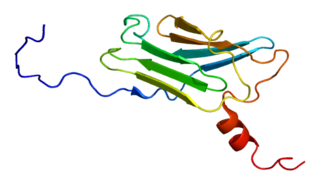
Calcyclin-binding protein is a protein that in humans is encoded by the CACYBP gene.

Kv channel-interacting protein 1 also known as KChIP1 is a protein that in humans is encoded by the KCNIP1 gene.
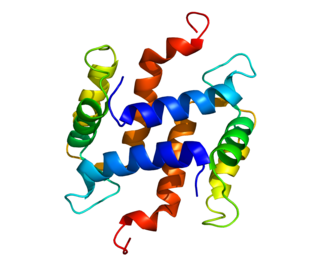
S100 calcium-binding protein A5 (S100A5) is a protein that in humans is encoded by the S100A5 gene.

S100 calcium binding protein A14 (S100A14) is a protein that in humans is encoded by the S100A14 gene.























